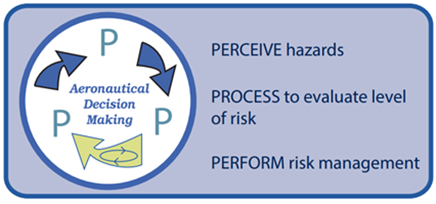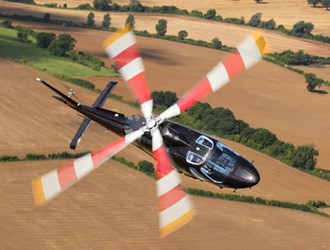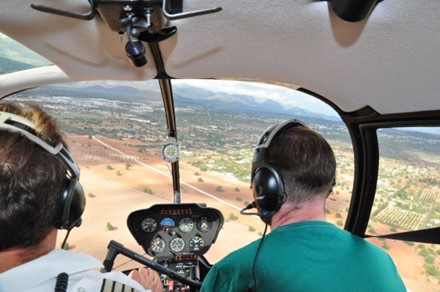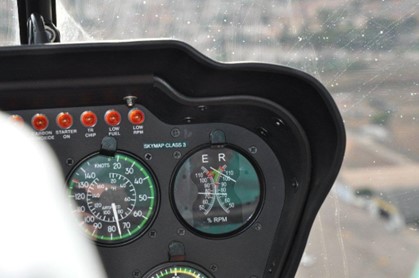Data confirms that a number of helicopter accidents continue to happen during the training or checking of Emergency and Abnormal Procedures (EAP), when the instructor has allowed the student to put the aircraft into a position where they were not able to recover the aircraft safely. Whilst the EASA Rotorcraft Safety Roadmap recommends, whenever possible, to train and check EAP in a Flight Simulator Training Device (FSTD), the reality is that they are not always available in practice. This means that instructors and examiners must still be able to safely train and check EAP in a real helicopter.
This article revisits some key points from the EHEST Leaflet HE 11 Training and Testing of Emergency and Abnormal Procedures in Helicopters, which provides guidelines to instructors and examiners to improve the safety and delivery of instruction and assessment of helicopter EAP.
Manoeuvre-Based Training
Manoeuvre-based training is crucial for mastering the fundamentals of aircraft control. During EAP instruction, recommended to be performed in the simulator, the instructor typically demonstrates and explains the signs of emergencies or abnormal situations. They then guide the student through the appropriate actions to take. The student practices these manoeuvres until they achieve the necessary level of handling competence.
The instructor should emphasise the importance of maintaining aircraft control and vigilance throughout the training session. They should also highlight which checks require reference to an Aircraft Emergency or Abnormal Checklist and which ones can be performed from memory (subject to discussion in the instructor community). Incorrect or rushed drills can exacerbate matters and increase hazards.
Scenario-Based Training
Scenario-based training is a potent instructional approach that incorporates real-world experiences to address training objectives. Emergency or abnormal scenarios provide an opportunity to experience contextualised situations that can occur during flight. Scenario-based training fosters systematic risk reduction and critical thinking skills. It effectively prepares pilots to make safe decisions in emergency and abnormal situations. Once the student becomes proficient in performing manoeuvres, scenario-based training can be performed in an aircraft. Simulators however allow for safe training and testing of situations and scenarios that would be too risky in an aircraft.
Scenario-based training allows the incorporation of several realistic elements:
Aeronautical Decision Making
Scenarios are set up to stimulate the student’s Aeronautical Decision Making (ADM) process in which the instructor responds to student behaviour in a manner that encourages safe judgements and decisions. It is important for the student to recognise hazardous situations and unsafe tendencies and replace them with good judgements and safe behaviour.
ADM is the process of selecting from several options or hypotheses and deciding and acting to bring about a desired result. ADM is a systematic approach to consistently determine a suitable (possibly the best) course of action in response to an emergency or abnormal situation or any situation calling for choices and decisions to be made.
Various models describe the ADM process, one of the simplest and easiest ones is the ‘Three P’ model consisting of Perceiving hazards, Processing information to evaluate level of risk and Performing risk management, i.e., preventing, detecting or recovering from a risky situation, monitoring how the situation evolves and taking further action as suitable:

Here is a possible application of the ‘Three P’ for the training of EAP:
Perceive – An emergency or abnormal situation can be detected in various ways: by hearing a warning or unusual noises, seeing a gauge, indication or alarm, sensing vibrations, smelling smoke or abnormal odours or sensing unusual aircraft behaviour or attitude like upset, stall, spin, dive, or detecting abnormal crew behaviour such as confusion or incapacitation.
Process – Once the emergency or abnormal situation is detected, the pilot may gain relevant information from a variety of sources and cross-check them for coherence assessment and validation. Whenever possible, the pilot should take some time to make decisions and avoid jumping to conclusions. He or she should consider various interpretations of information before concluding, looking also for information possibly disconfirming an initial hypothesis. Trying to identify all possible explanations could be detrimental because requiring to much time and mental resources and the situation may require fast action.
Perform – Based on gathered information, a decision is taken regarding a suitable (possibly the best) course of action. Defining the best course of action can also be too costly because of the time and mental resources this could require. Once an appropriate action is taken, the situation is monitored, reviewed and evaluated and action is adapted as appropriate.
Startle and surprise effect
Facing an emergency or abnormal situation is stressful and will automatically trigger a startle or surprise reaction. Startle and surprise can provoke inaction (freezing at the controls) or on the contrary an urge to act and resolve the situation quickly. It can also induce a certain degree of mental (cognitive and emotional) confusion, affect perception (‘tunnel vision’) and lead to take incorrect actions, possibly continued or repeated over time despite ineffective (fixation error). The instructor should teach the pilot to stay calm and keep on flying the aircraft, i.e. to aviate, navigate and communicate in that order.

If certain situations require immediate action, many will tolerate a short delay to gather information, assess the situation and define a suitable course of action.
To cope with startle and surprise, don’t rush, breath and relax musculature before acting. And when possible, work as a team. Refer for instance to the EASA research study report Startle Effect Management - EASA_REP_RESEA_2015_3 | EASA (europa.eu).
Scenario-Based Testing
AMC 2 FCL.1015 states that a test or check is intended to simulate a practical flight. Therefore, an examiner may set practical scenarios for an applicant whilst ensuring that the applicant is not confused, and flight safety is not compromised.
In the planning stage, the examiner must decide which EAP he or she wants to demonstrate in flight, as opposed to those to discuss in the classroom. As a general principle, ‘Show me what you would do’ should be used in flight whereas ‘Tell me what you would do’ should be reserved for the classroom.
To ensure maximum benefit, scenario-based testing should permit ADM, Threat and Error Management, Crew Resource Management and knowledge of the Pilot’s Operating Handbook, Flight Manual and Standard Operating Procedures, and not just demonstrate the candidate’s handling skills.
Common Considerations
Briefings and de-briefings
Before training or testing flights, a comprehensive briefing should cover the following aspects:
- Division of responsibility and Pilot in Command (PIC) responsibilities: Clearly define the roles and responsibilities of the student and instructor/examiner during the flight.
- Sequence of events: Outline the planned sequence of events during the flight, including take-off, manoeuvres, and landing.
- Emergency procedures: Explain how to handle real emergencies during training.
- Throttle, fuel control lever, and engine manipulation: Discuss the proper use of these controls.
- Touch drills: Clarify when and how touch drills (identifying controls by touch) will be performed.
- Malfunction simulation: Describe how system malfunctions will be simulated.
- Warning system de-selection and re-selection: Cover procedures related to warning systems.
- Non-standard drills: Address any non-standard procedures.
- Special considerations: Discuss weather conditions, circuit patterns, terrain, and other relevant factors.
Just before the flight, perform a re-brief and a practice on the ground as appropriate. The candidate will identify the appropriate control(s) to be operated and will only manipulate the control(s) when he or she receives a confirmation and a verbal command from the instructor or the examiner to do so.
Whilst the instructor demonstrates the actions for dealing with a system malfunction, the candidate could be requested to assist by deselecting or operating the system controls to simulate the failure of the system. In such cases, the pre-flight briefing should include the relevant control, when the control is to be manipulated, how the control is manipulated, by whom and by how much, the process for resetting the control and the verbal commands that will be used.
After the flight, debriefing should assess the applicant’s performance and document the test or check.
Conduct a fair, unbiased debriefing based on factual evidence. Maintain a balance between friendliness and firmness.
Advise the candidate on avoiding or correcting mistakes, highlight critical points and provide additional advice.
Conduct the debriefing in private, respecting the student’s sensitivities.
Praise the candidate for good performance and reinforce confidence. Confidence is crucial for effective and safe piloting in the operational environment.
Hazards involved in simulating system failures and malfunctions
Instructors and examiners should use the TEM principles to identify and assess the threats that could be encountered during the flight. The candidate and his or her action or inaction could also be considered as a source of threat.
Appropriate mitigations should be considered prior to and during the flight, including taking control when needed. Refer for instance to the EHEST Leaflet HE 8 The Principles of Threat and Error Management for helicopter Pilots, Instructors and Training Organisations | EASA (europa.eu).
Flight instructors are required to have completed the Teaching and Learning Syllabus at AMC1FCL.930.FI. Item (i) of the syllabus is “Specific hazards involved in simulating systems failures and malfunctions in aircraft during flight”, which lists the following items: (i) importance of touch drills (ii) situational awareness and (iii) adherence to correct procedures.
Importance of touch drills
‘Touch Drills’ are employed when identifying an aircraft system by touch (or pointing) without taking further action. The purpose is to ensure that a pilot can promptly identify and reach the relevant system control without inadvertently manipulating it, thus preventing accidental selection or de-selection of the system. Before any flight involving simulated emergency drills, it is crucial for the instructor or examiner to establish the student’s understanding of how and when touch drills should be performed. The instructor or examiner should closely monitor the student’s actions to prevent inadvertent system activation or deactivation.
Situational awareness
As the instructor or examiner bears ultimate responsibility for the safety of the aircraft and its occupants, they must avoid placing it in hazardous situations. Continual assessment of potential hazards in the operating environment during training or testing flights should consider factors such as ground proximity, obstacles, other traffic, escape routes, terrain, minimum heights for initiating and recovering from EAP, weather conditions, aircraft performance, and the instructor’s or examiner’s experience. During initial instruction and demonstrations, be aware that the student’s overall situational awareness may be compromised as they focus on handling the emergency.
Adherence to procedures
The Flight Manual or Approved Training Organisation training manual usually state the conditions or techniques to be used for the training, for example Weight Altitude Temperature charts, Maximum All Up Mass, max speeds, training limitations, minimum heights, areas to be used and crew composition.
Overconfidence or Overestimation of the Candidate’s Competencies
It can happen that an instructor or examiner is teaching or testing a more senior or experienced pilot.
As perceived ability is often tied to status and seniority, this can lead to assume that the candidate has more ability they have and that they know what they do. Overestimation and overconfidence can lead to a reluctance to take control. Other factors can be the desire to give the candidate more chance to succeed, excessive courtesy or cultural restraints.
Conversely, the candidate could try to hide that they cannot perform the procedure and be reluctant or ashamed to ask the instructor or examiner to take control, fearing failure of the test or loss of face (culture is a strong factor).
It can also happen that an instructor or examiner must train or test a pilot of comparative ability, in particular a colleague or friend. This can also lead to a relaxation in procedures and in some cases, an inadvertent element of competitiveness.
Caution: The instructor’s or examiner’s reluctance to take control, combined with the candidate’s reluctance to declare that they cannot cope can also lead to an Undesired Aircraft State (UAS), thereby, resulting in an avoidable training or testing accident.
Additional factors contributing to training and testing accidents are insufficient situational awareness or poor risk assessment by the instructor or evaluator, allowing the situation to develop for the purpose of training or testing, and distraction.

Safety tips:
- Beware of overconfidence or overestimation of the candidate’s competencies.
- Instructors or examiners should never hesitate to question the candidate performance and to take control in due time.
- Candidates should never hesitate to declare that they cannot cope, to call for help and to transfer control to the instructor or examiner.
Autorotations and Simulated Engine Off Landings
The teaching and testing of autorotations to a power recovery in a Multi Engine Helicopter and to a Simulated Engine Off Landing (SEOL) in Single Engine Helicopter, sometimes referred to as touchdown autorotations or autorotative landings, is a requirement of EASA PPL, CPL, ATPL, FI and Type Rating courses.
Prior to conducting this exercise the following precautions should be taken:
Pre flight
A risk assessment should be conducted in accordance with the ATO SMS taking in consideration:
- weather: wind velocity, visibility, light levels, sun glare/shadow, precipitation, etc.,
- the landing area surface: size, level, flat, firm, wet or dry,
- ATC and airfield operations: ability to approach and land into wind if different from the established circuit direction,
- other local traffic,
- availability of rescue and fire-fighting services,
- instructor or examiner currency: when last flown SEOL,
- aircraft performance and suitability: weight, equipment, insurance, and
- briefing: verbal commands, throttle or Flight Control Lever drills, touch drills, take over and go-around procedures and acceptable Rate Of Descent.
Flight prior to entry into autorotation
The following should be considered:
- height: appropriate height above the ground to be able to establish a stable autorotation,
- area: suitable and clear,
- no loose articles in the cockpit that could move and jam the controls,
- engine Torque and Power: check that all cockpit indications are normal, carburettor heat applied if applicable, engine air bleeds deselected if appropriate,
- lookout throughout the exercise especially below the helicopter and into the landing area,
- wind: too much, too little, gust spread, windshear, turbulences, and
- weight: light All Up Mass: possible rotor speed (Nr) decrease vs. heavy All Up Mass: possible Nr increase and increased rate of descent.
Flight (in autorotation)
By 300ft AGL at the latest, the following should be considered:
- no slip and no drift,
- rate of Descent within pre-defined limits,
- rotor speed within limits,
- airspeed within the recommended speed range and landing area suitability and reachability.
Caution: If not appropriate a go‑around should be initiated.
Flight (flare/check)
At the height and speed stated in the Pilot’s Operating Handbook or Flight Manual, the flare, check and level should be commenced as appropriate to aircraft type and the power re-applied for a multi-engine helicopter if not already applied.
Flight (touchdown)
The correct landing attitude should be maintained, whilst also maintaining the heading and smoothly lowering the collective where appropriate.
For conducting SEOLs, avoid no ‘notice throttle chops’ as they have little value and can cause accidents. Always follow through on the controls, do not perform more autorotations or SEOLs than required in one flight as it can lead to complacency and consider completing a power recovery, prior to the engine off landing, to gauge the conditions.
During a test or check when unsure of candidate’s capabilities, consider completing an exercise such as a limited power running landing prior to a SEOL to ensure the candidate can gauge the landing attitude (controversial in the instructor community, as a limited power running landing can be as risky as a SEOL on some types of helicopters), keep the aircraft straight and lower the lever appropriately. In deciding a safe height for an engine re-engagement during a power recovery, consider the delay in the response time for the engine to ‘spool up’, Rate Of Descent, All Up Mass and environmental conditions.

When the procedure is completed, verify that any systems that were deselected to simulate the emergency are reset before continuing with the flight. The candidate should also be informed that the emergency is complete before continuing with the flight or subsequent EAPs.
Refer also to Part 2 Air Exercises 10. Basic Autorotation and 20. Advanced Autorotation of the EASA Together4Safety Helicopter Flight Instructor Guide - Issue 4.0 | EASA (europa.eu) and the EHEST Helicopter Flight Instructor Manual – Issue 1| EASA (europa.eu) on which it is based. Also check the Air Exercise 14c – Emergency Procedures.
The EHEST Leaflet HE 5 Risk Management in Training | EASA (europa.eu) provides tools and methods for risk assessment and management in training. Training for autorotation is used as a practical example to illustrate the method.
Check out also this previous article: Autorotation Management and Training | EASA Community (europa.eu).
Principles and Methods of Instruction
Principles and methods of instruction and evaluation are provided in Part 1 of the EHEST Helicopter Flight Instructor Manual – Issue 1| EASA (europa.eu) and its successor, the EASA Together4Safety Helicopter Flight Instructor Guide - Issue 4.0 | EASA (europa.eu).
References
Rotorcraft Safety Roadmap - Final.pdf (europa.eu).
Easy Access Rules for Flight Crew Licencing (Part-FCL) | EASA (europa.eu).
EHEST Helicopter Flight Instructor Manual – Issue 1| EASA (europa.eu).
EASA Together4Safety Helicopter Flight Instructor Guide - Issue 4.0 | EASA (europa.eu).
Startle Effect Management - EASA_REP_RESEA_2015_3 | EASA (europa.eu).
EHEST Leaflet HE 5 Risk Management in Training | EASA (europa.eu).
Autorotation Management and Training | EASA Community (europa.eu).
Michel, I would like to add a couple of thoughts.
A. Decision to continue. In addition to ensuring that there is no skid or drift at 300 ft, I would add that you do not want to be in a turn at below 300 ft. A turn can significantly increase your rate of descent which may not be containable in the limited height remaining.
B. Double engine idle autorotation. You do not cover the particular hazards of practicing autorotations by regarding both engines in a multi engine helicopter back to idle. There needs to be a very specific briefing before hand and several careful risk mitigations. The following needs to be covered:
I. The method of entry and timing of bringing the engines to idle. This we do as single engine retarded to idle (keeping inside MCP OEI limits) then retarding the second engine as the cue for the student to enter whilst guarding the collective as the instructor.
II. The process and timing for reintroducing power. I usually do so no later than 1000 ft/rad alt bug audio which is also set as 1000 ft.
III. Type specific risks of inadvertantly selecting off - eg on AW109 the off gate is very easy to inadvertently override as it is released by pressure down with the instructors hand.
IV. The actions in the event of an extra emergency. This is always to put the engines back first and making the availability of power clear to the student (so they don't pull too early)
V. Always flying as though the engines cannot be returned to full power and briefing the student as such.
VI. Use of appropriate height alerts (rad alt/da bug)
I never brief this except immediately before the manoeuvre to keep it fresh in the instructor and students mind.
C. Preparation for SEOL training. I think the appropriate manoeuvre to fly before a set of practice autorotations is a power-on autorotation to a low hover taxy. This allows judgement of the wind, effect of the flare and height judgement. A limited power landing is a very different technique.
Warm thanks, Georges, for these relevant additions.
Comments and complements of information are very welcomed.
Please log in or sign up to comment.